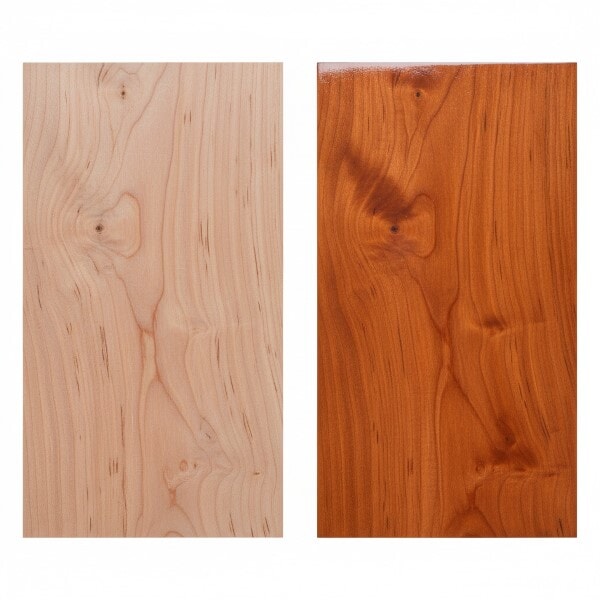
Hardwood and softwood — you hear those terms tossed around in hardware stores, DIY videos, and woodworking classes. But what do they really mean?
Many new woodworkers assume hardwoods are always tough and softwoods are, well, soft. Logical, right? Yet that’s not how the labels work.
If you’ve ever wondered why pine holds up a house while balsa barely holds a model airplane, you’re about to find out.
Hardwoods vs. Softwoods: What the Labels Really Mean
The names “hardwood” and “softwood” have nothing to do with hardness.
They’re based on the biology of the tree — not how difficult the wood is to dent or cut.
Hardwoods come from deciduous trees that lose their leaves each year — oak, maple, cherry, walnut. They often have distinct grain and color patterns.
Softwoods come from conifers like pine, fir, spruce, and cedar — evergreens that keep their needles year-round and grow faster.
So a hardwood isn’t necessarily hard, and a softwood isn’t necessarily soft. It’s about how the tree grows, not how tough it feels.
How This Classification Came to Be
The confusion goes back centuries. Botanists in the 1600s classified trees by reproductive structures — cone-bearing evergreens versus flowering broadleafs.
These were simply shorthand for botanical families at that time.
By the mid-1800s, foresters, lumbermen, and engineers started adopting the same classifications for their timber descriptions — and that’s the system we still use today.
Why Some Hardwoods Are Soft (and Some Softwoods Are Hard)
That question isn’t new — even early lumbermen were scratching their heads about it.
People noticed that balsa, technically a hardwood, was one of the softest woods you could find. Yet heart pine, a softwood, could be harder than cherry or even oak.
If you’ve ever dropped a clamp on a pine board, you’ve seen the Janka test in action — that dent is your unscientific version of it.
This confusion eventually led to what we now call the Janka Hardness Scale, a standardized way to measure how resistant a wood is to denting or wear.
The Janka Hardness Scale: Measuring What Matters
Developed in 1906 by Austrian wood researcher Gabriel Janka, this test measures the force required to embed a .444-inch steel ball halfway into a wood sample.
The higher the number, the harder the wood.
| Wood | Type | Janka Rating (lbf) |
|---|---|---|
| Balsa | Hardwood | 100 |
| White Pine | Softwood | 380 |
| Heart Pine | Softwood | 1,225 |
| Red Oak | Hardwood | 1,290 |
| Maple | Hardwood | 1,450 |
Red oak is the unofficial benchmark many woodworkers use for comparison.
As you can see, heart pine nearly matches it — proof that “softwood” doesn’t always mean weak.
Most of the Janka charts you’ll find online list woods from about 100 lbf (basswood or cottonwood) up to 3,680 lbf for Ipe, with some exotics testing even higher.
Below you can see a sample of the common domestic woods found across North America. Some are widely available, while others are more regional because of limited harvesting or local demand.

Janka Hardness Scale of common North American wood species.
In addition to domestic species, you’ll often find exotic woods for sale with striking grain patterns and vibrant colors.
Exotic Woods You’ll Find at Lumber Dealers and in Woodshops (Click to View)
Note: Species marked with an asterisk ( * ) are regulated under CITES Appendix II. Purchase only from verified sustainable or reclaimed sources.
| Species | Janka (lbf) | Characteristics & Common Uses |
|---|---|---|
| Ipe (Brazilian Walnut) | 3,680 | One of the densest woods on earth; used for exterior decking and heavy-wear flooring. So dense it sinks in water. |
| Cocobolo * | 2,960 | Striking orange-red with dark streaks; oily, aromatic. Popular for knife handles & instruments. Highly restricted. |
| Bloodwood | 2,900 | Deep crimson, polishes like glass. Used for turned pens and detail accents. |
| Olivewood | 2,710 | Beautiful swirling grain with a sweet scent. Used for kitchen utensils and decorative turnings. |
| Brazilian Cherry (Jatoba) | 2,350 | Dense, durable flooring wood; ages to deep mahogany tones. |
| Bubinga * | 1,980 | Heavy, figured hardwood used in instruments and fine hand tools. CITES-regulated. |
| Purpleheart | 1,860 | Turns vivid purple when cut; darkens with UV. Excellent for inlay & accents. |
| Yellowheart | 1,790 | Bright yellow tone; great for segmented turning & contrast pieces. |
| Rosewood * | 1,780 | Classic tonewood for guitars and fine furniture. All Dalbergia species protected. |
| Padauk (African) | 1,725 | Vivid orange-red that browns with age; used for tool handles & boxes. |
| Wenge | 1,630 | Nearly black with subtle striping; splinter-prone. Used for modern furniture accents. |
| Zebrawood | 1,575 | Bold striped pattern; used in veneered cabinetry and instruments. |
| Canarywood | 1,520 | Yellow-orange with red streaks; easy to machine and finish. |
| Redheart | 1,210 | Bright coral-red; great for inlays & turned ornaments. |
| Teak | 1,155 | Oily, weatherproof; ideal for outdoor and marine applications. |
| Makore * | 1,100 | Fine-textured mahogany type used in yachts and cabinetry. |
| Lacewood / Leopardwood | 840 | Distinctive lace-like flecks; popular for jewelry boxes and panels. |
| African Mahogany (Khaya) | 830 | Lightweight, warm tone; common for furniture & trim. |
🌿 Responsible Sourcing Reminder: Even non-CITES species can be overharvested. Choose FSC or PEFC-certified lumber, reclaimed stock, or reputable specialty dealers whenever possible.
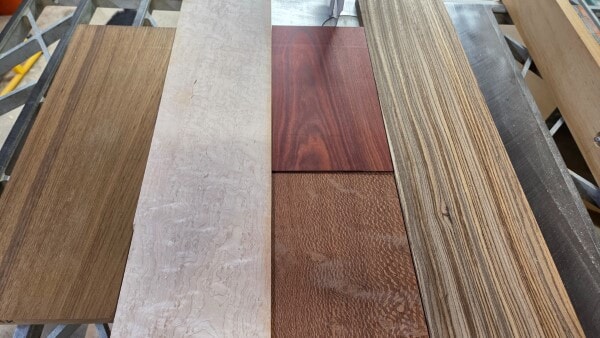
These hardwoods reveal dramatic color and figure when finished.
From left: Teak and Curly Maple, Bloodwood above, Lacewood below, and Zebrawood on the right.
When comparing hardness, many articles use Red Oak (1,290 lbf) as a baseline. For instance, Cherry (995 lbf) is softer, while Heart Pine (1,225 lbf) — though technically a softwood — comes close to matching it.
Video: A simple breakdown of hardwood vs. softwood — and why the names don’t mean what you think.
What Do I Want to Build With — Hardwood or Softwood?
The answer to that question is both easy and hard.
The easy answer? Both.
The hard (and more honest) answer is that it depends on what you want to build and how you want it to look.
As woods get harder, tool selection and sharpening matter more. Even simple cuts feel different when you move from pine to maple or from cherry to purpleheart. If you’d like a clearer sense of how different tools handle different woods, my Types of Woodworking Tools guide walks through what each tool does and how to choose the right one for the job.
And here’s the part that surprises many beginners: softness has very little to do with strength or with longevity. There are examples of pine furniture from the 1700s still solid and in daily use today. Pine can be durable — it just dents easier.
Hardwoods are timeless and elegant but can also be heavier, harder to work, and more expensive.
For beginners, I always recommend starting with pine. It’s affordable, forgiving, and beautiful when finished well. If you’re new to woodworking, you might also enjoy my Beginner Mistakes to Avoid in Woodworking — it’ll save you a lot of frustration early on.
As your skills grow, so will your lumber choices.
I’ve got a small hoard of domestic and exotic woods in my shop — from full boards to small offcuts for inlays and turnings. Every piece has its own story waiting to be told.
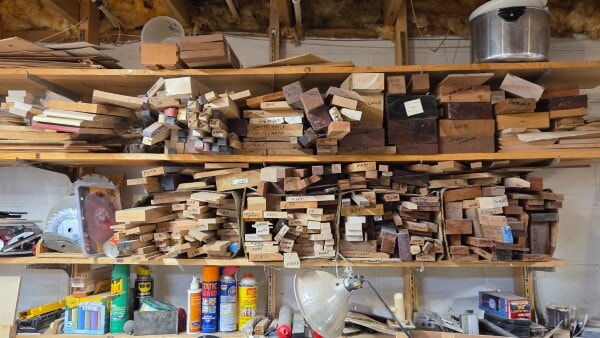
Mike’s collection of small exotic and domestic offcuts — each with a future project in mind. Most are labeled with the wood type on the end for ease of use.
Hardness doesn’t always equal quality. Sometimes the best wood for a project is the one you’re not afraid to make mistakes on.
History of Some Wood Uses
It’s interesting how some woods have been used through the years.
Osage Orange wood, for example, was once used as bearings in manufacturing machinery before synthetic materials existed. Its natural oils gave it incredible durability and self-lubrication.
Live Oak is another example — an incredibly dense and tough wood. The USS Constitution (“Old Ironsides”) was built from live oak, and it earned its nickname because cannonballs bounced off its hull.
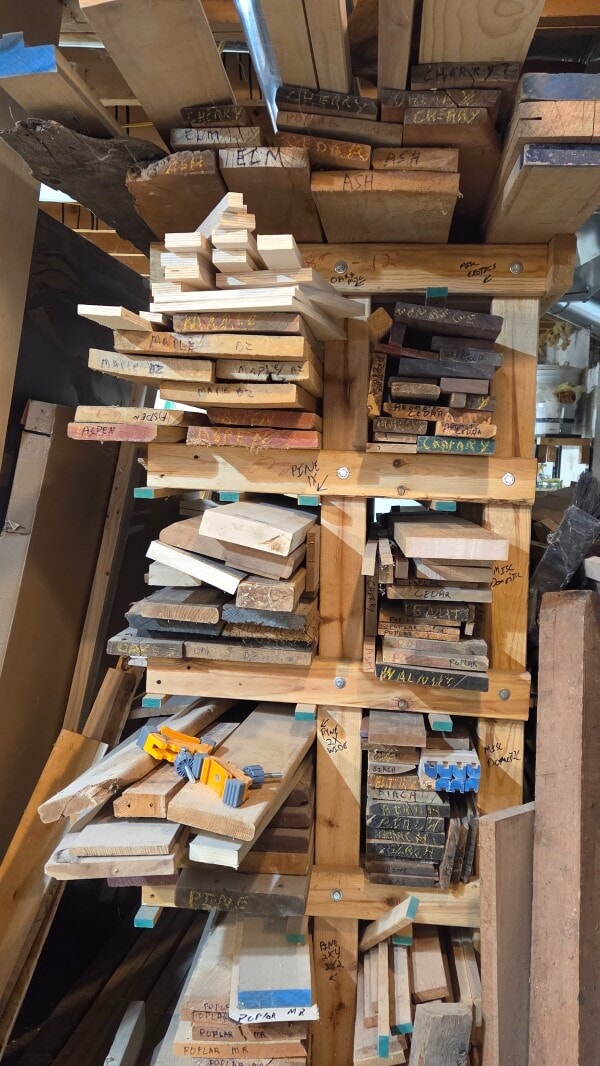
The lumber rack at The Master’s Workshop of WI — organized chaos built on tradition. Most pieces labeled on end for easy identification.
From ships that had to survive cannon fire to hand tools that last a lifetime, wood has always been chosen for what it does best.
The Practical Side of Wood
Woodworking is about purpose, not prestige. Every species has its place.
I still use a lot of pine in my shop — 1×4s and 2×4s, or whatever width fits the project. Pine is great for mockups or test builds because it’s inexpensive and forgiving.
If I need to tweak a design or cut a piece twice, I don’t feel bad about it.
I also use pine for shelving — it’s strong, affordable, and easy to work with.
For drawer boxes, I like birch or aspen — they plane smooth, look clean, and make for silky-smooth sliding drawers.
And when I want something special, I reach for oak, maple, cherry, or walnut, depending on the look and finish I want.
As mentioned in my Step-by-Step Guide to Your First Woodworking Project, the pine bookshelf I made 30 years ago is still in use today — and that piece was built long before I had a dedicated shop. Over the years, I’ve learned that a good workspace matters just as much as good wood. If you’re still shaping your space, you may find my guide on Setting Up Your Woodworking Shop: A Practical Guide especially helpful.
👨🔧 Mike’s Memory:
Every time I look at that old bookshelf, I’m reminded that craftsmanship outlasts the materials — if you build it right, it lasts.
Pine or Oak — Both Worth Building With:
These two projects from my shop show that quality craftsmanship outshines wood labels. Katie’s deacon bench, built from pine, has a warm, welcoming feel and has held up beautifully over time. Cindy’s oak shoe cabinet, on the other hand, shows how a dense hardwood can be both elegant and practical for everyday use. Whether it’s softwood or hardwood, it’s the skill and care behind the build that make it last.
Deacon Bench Hope Chest — Pine, finished with clear polyurethane.


Cindy’s Oak Shoe Cabinet — hardwood strength and everyday beauty.
Choosing Wood for Your Next Project
Before you decide, ask yourself:
Purpose: Will it take daily abuse or just look pretty?
Appearance: Rustic, modern, or classic?
Budget: Skill can make cheap wood look expensive.
Tools: Dense woods demand sharper edges.
Finishing: Test stain on scrap — cherry, maple, and pine can surprise you.
Following, you can see a sample of how different woods look before and after finishing. Each image shows a plain, unfinished board next to one coated with an oil-based polyurethane finish — revealing how the wood’s natural color, grain, and luster come to life once sealed.
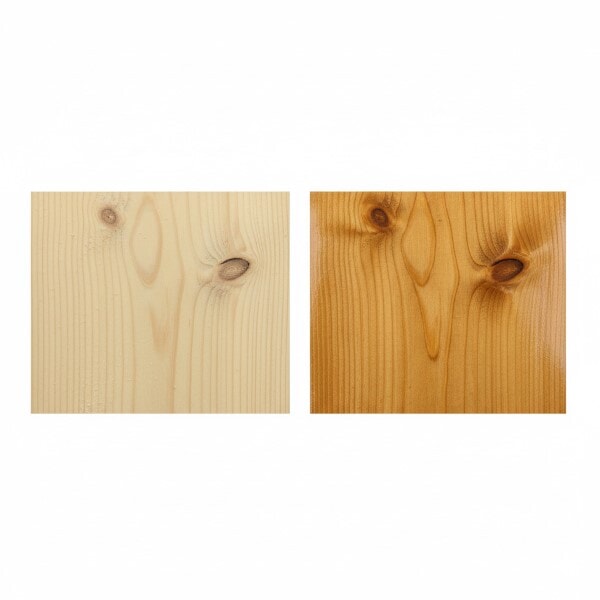
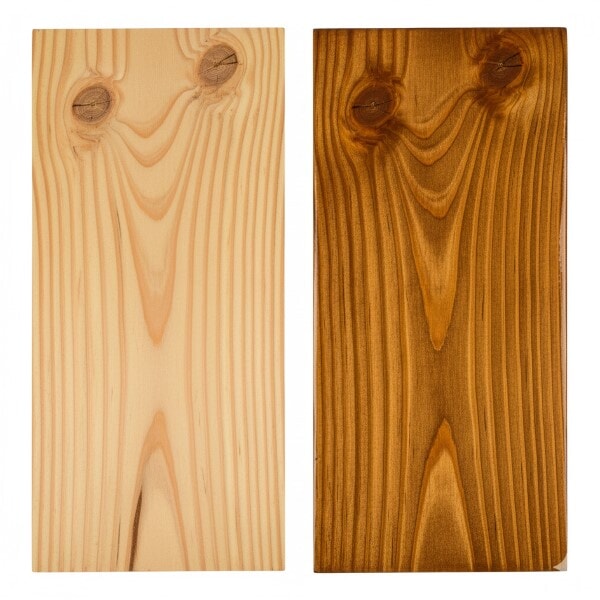

Pine
Southern Yellow Pine
Box Elder
💡 Pro Tip:
Always match the wood to the purpose, not the name. Pine makes great furniture when used right — just as cherry makes a poor sawhorse.
Where to Find Good Wood
Finding quality lumber can feel like a scavenger hunt. Here are some of the best places to start:
Home Centers & Big-Box Stores: Great for softwoods and common hardwoods like oak, maple, or poplar. Boards are usually pre-surfaced and ready for small projects.
Local Lumberyards: Offer a wider variety, better grades, and solid advice from people who know their wood.
Local Sawmills: Ideal for rough stock and unique species — often at better prices. Many can be found through online searches or Facebook Marketplace.
Online Suppliers: Reliable sources for exotics or small project packs (just watch the shipping costs).
Reclaimed Sources: Old furniture, barn wood, and even pallets can yield beautiful surprises when cleaned up.
Cabinet and Woodworking Shops: Many have scrap or offcut bins that are free or inexpensive — great for small projects, turnings, or test pieces.
💡 Pro Tip:
Always check moisture content before milling — anything above 12 % needs more drying time
From My Bench to Yours
We’ve covered a lot here — how hardwoods and softwoods got their names, what the Janka scale really tells us, and how the wood you choose shapes the project just as much as the tools you use.
But at the end of the day, every board has its own story — and every project carries the hands and heart of the person who made it.
Whether it’s a pine bookshelf that’s been holding memories for decades, or a cherry box that glows when the light hits it just right, what lasts isn’t the hardness of the wood — it’s the care you put into shaping it.
Now go build something that lasts — and let me know what you choose. I’d love to hear your story.
🎯 Reader Challenge:
Think of a project you’ve built that’s held up over time — what wood did you use? Share it in the comments below!And if you’d like a deeper look into specific wood species or shop techniques, let me know in the comments — I’m always up for talking tools and timber.
Mike’s Favorites
These are the tools I reach for on almost every project. The seven below are my quick-grab essentials—open the full list for everything I keep on the bench and in my apron.
Top 7 Essentials
- iGaging 6″ Fastener Cal Digital Caliper — Quick, precise checks.
- iGaging 7” and 12” Layout Square Set (also available at Taylor Toolworks) — Reliable layout reference.
- Starrett 6″ Double Square — Everyday layout accuracy.
- Woodcraft 16 ft Tape Measure (Fractional) — Compact; blade stays out on its own.
- Taytools Stainless Steel 6″ Machinist Ruler (4R) — My most-used small measuring tool.
- RZ Mask M2 9-Piece Woodworker’s Kit — Reusable protection against fine dust; far more comfortable than disposables (also available at Amazon).
- ISOtunes PRO 3.0 Bluetooth Hearing Protection — OSHA-certified hearing protection with streaming and calls.
➤ See my full list of Favorites
On the Bench Tools
- iGaging IMPERIAL Bench Squares – Stainless steel blades with wide anodized aluminum base.
- iGaging 7” and 12” Layout Square Set – Anodized aluminum (also available at Taylor Toolworks).
In My Apron Tools
- Katz-Moses 20 oz Waxed Canvas Tool Apron (The apron isn’t in my apron—LOL—but I’d be lost without it.)
- iGaging 6″ Fastener Cal Digital Caliper
- 6-Pack Mechanical Carpenter Pencils with Sharpener and Refills
- Pentel GraphGear 1000 Mechanical Pencil
- Calculated Industries 4019 Material Estimator Calculator
- Woodcraft 16 ft Tape Measure (Fractional) or FastCap Old Standby 16 ft (also at Taylor Toolworks). I prefer the Woodcraft because it’s smaller and the blade stays out on its own. The FastCap works too, but you have to lock and release the blade each time.
- Starrett 6″ Double Square – Hardened graduated blade.
- Starrett 4″ Double Square – Satin chrome finish, hardened blade.
- iGaging 4″ & 6″ Double Square Set (also at Taylor Toolworks). I was gifted my Starrett squares and treasure them, but this iGaging set is a well-made, affordable alternative I’d recommend if you’re buying your own.
- Lufkin Red End Extension Folding Rule (5/8″ × 6 ft) or Crescent Lufkin Wood Rule (6′ Brass Extension). I keep a folding rule for places a tape can’t manage—checking inside a box for square, or when I need a longer, rigid measure. Get one with a brass extension so you can capture full measurements when another arm won’t swing into place.
- Taytools Stainless Steel 6″ Machinist Ruler (4R) Even with other measuring tools, this little rule probably gets used the most.
- EverBrite 9-LED Flashlight, 6-Pack (Assorted Colors)
- Mikov Thin Blade Dual Bevel Marking Knife (0.060″, Rosewood Handle)
- Narex Thin Blade Dual Bevel Striking Marking Knife (also at Amazon). Yes, I carry two knives: this one’s longer for reach where the Mikov can’t go.
Shop Safety Essentials
- RZ Mask M2 9-Piece Woodworker’s Kit — Breathable, reusable, and essential for sanding/cutting (also available at Amazon).
- ISOtunes PRO 3.0 Bluetooth Hearing Protection — OSHA-certified hearing protection with streaming and calls.
Some links above are affiliate links. Thanks for supporting The Master’s Workshop of WI!
This list is updated as I refine my shop setup and favorite tools.

